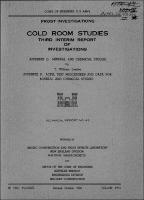Please use this identifier to cite or link to this item:
https://hdl.handle.net/11681/6528| Title: | Frost investigations : cold room studies : third interim report of investigations, volume 2 |
| Authors: | United States. Army. Corps of Engineers. New England Division Lambe, T. William |
| Keywords: | Soils Soil chemistry Admixtures Frozen soils Frozen ground Permafrost Soil mechanics Frozen ground mechanics Frost Frost penetration Frost heave Frost heaving Frost action Freezing Thawing Testing Tests Cold room studies |
| Publisher: | Arctic Construction and Frost Effects Laboratory (U.S.) Engineer Research and Development Center (U.S.) |
| Description: | Technical Report Summary: This report describes research aimed at: (a) determining the effect of composition of soil fines on the frost susceptibility of the soil, and (b) finding admixtures which can in trace amounts reduce the frost susceptibility of soil. Freezing tests were run on a clean sand to which various monomineral fines had been added. The data, which in most cases are explained in terms of the mineral structure, show that the composition of soil fines has a tremendous influence on the frost behavior of the soil. The nature of the exchangeable ion has a pronounced effect on the frost-heave-producing ability of montmorillonoid fines. A theoretical discussion shows how trace chemicals can reduce frost susceptibility of a soil by one or more of three mechanisms, namely: (a) altersoil structure, (b) waterproof, and (c) alter permeability. Limited tests show that dispersants, which alter soil structure, have considerable promise as frost modifiers. For example, a one percent treatment of sodium tetraphosphate reduced the rate of heave of a sandy clay from an average of 1.7 mm/day to 0.08 mm/day, a reduction of about 95 percent. Several waterproofers also showed promise. |
| Rights: | Approved for public release; distribution is unlimited. |
| URI: | http://hdl.handle.net/11681/6528 |
| Appears in Collections: | Technical Report |
Files in This Item:
| File | Description | Size | Format | |
|---|---|---|---|---|
| ACFEL-Technical-Report-43-Volume-2.pdf | 8.27 MB | Adobe PDF |  View/Open |